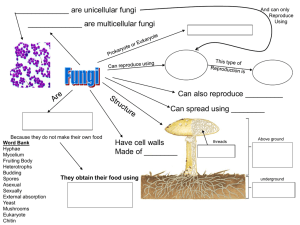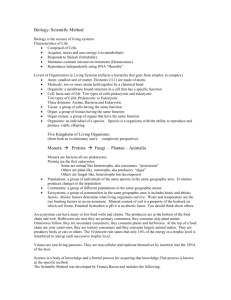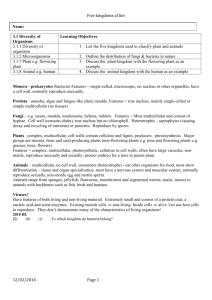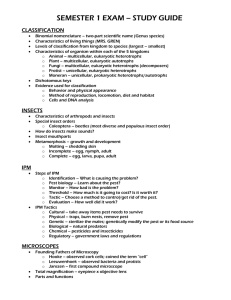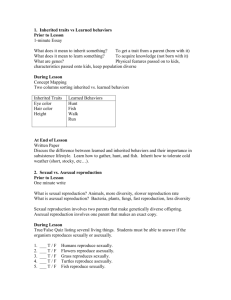Biology: Chemistry
advertisement
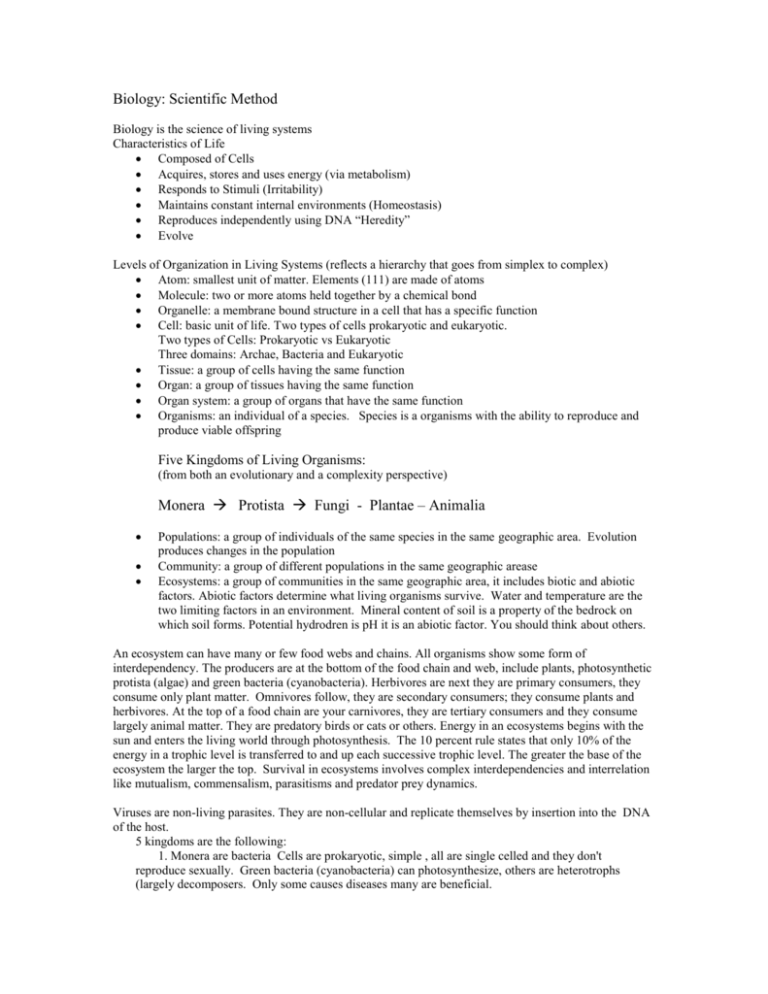
Biology: Scientific Method Biology is the science of living systems Characteristics of Life Composed of Cells Acquires, stores and uses energy (via metabolism) Responds to Stimuli (Irritability) Maintains constant internal environments (Homeostasis) Reproduces independently using DNA “Heredity” Evolve Levels of Organization in Living Systems (reflects a hierarchy that goes from simplex to complex) Atom: smallest unit of matter. Elements (111) are made of atoms Molecule: two or more atoms held together by a chemical bond Organelle: a membrane bound structure in a cell that has a specific function Cell: basic unit of life. Two types of cells prokaryotic and eukaryotic. Two types of Cells: Prokaryotic vs Eukaryotic Three domains: Archae, Bacteria and Eukaryotic Tissue: a group of cells having the same function Organ: a group of tissues having the same function Organ system: a group of organs that have the same function Organisms: an individual of a species. Species is a organisms with the ability to reproduce and produce viable offspring Five Kingdoms of Living Organisms: (from both an evolutionary and a complexity perspective) Monera Protista Fungi - Plantae – Animalia Populations: a group of individuals of the same species in the same geographic area. Evolution produces changes in the population Community: a group of different populations in the same geographic arease Ecosystems: a group of communities in the same geographic area, it includes biotic and abiotic factors. Abiotic factors determine what living organisms survive. Water and temperature are the two limiting factors in an environment. Mineral content of soil is a property of the bedrock on which soil forms. Potential hydrodren is pH it is an abiotic factor. You should think about others. An ecosystem can have many or few food webs and chains. All organisms show some form of interdependency. The producers are at the bottom of the food chain and web, include plants, photosynthetic protista (algae) and green bacteria (cyanobacteria). Herbivores are next they are primary consumers, they consume only plant matter. Omnivores follow, they are secondary consumers; they consume plants and herbivores. At the top of a food chain are your carnivores, they are tertiary consumers and they consume largely animal matter. They are predatory birds or cats or others. Energy in an ecosystems begins with the sun and enters the living world through photosynthesis. The 10 percent rule states that only 10% of the energy in a trophic level is transferred to and up each successive trophic level. The greater the base of the ecosystem the larger the top. Survival in ecosystems involves complex interdependencies and interrelation like mutualism, commensalism, parasitisms and predator prey dynamics. Viruses are non-living parasites. They are non-cellular and replicate themselves by insertion into the DNA of the host. 5 kingdoms are the following: 1. Monera are bacteria Cells are prokaryotic, simple , all are single celled and they don't reproduce sexually. Green bacteria (cyanobacteria) can photosynthesize, others are heterotrophs (largely decomposers. Only some causes diseases many are beneficial. 2. Protista are the first eukaryotes, As eukaryotes they are more complex. some reproduce sexually and asexually. Some are single celled others are multicellular Some are animal like heterotrophs, aka consumers “protozoans” Others are plant-like, autotrophs, aka producers “algae” they photosynthesize Others are fungal-like, heterotrophs but decomposers 3. Fungi: All are eukaryotics, cell are elongated and called hypha, they reproduce sexually and asexually using “spores”. All are multicellular. They are heterotrophs and they are decomposers. 4. Plants: All are producer (autotrophs) that have large eukaryotic cell that are typically green, 3 organelles are unique to plants (vacuoles, chloroplast, cell walls). They have more organelles than other eukaryotes. All are multicellular and reproduce sexually and asexually. There are 4 phyla of plants you will learn about. 5. Animals: All are heterotrophs and cells are eukaryotic. All are mobile, multicellular, and reproduce sexually. There are 9 animal phyla you will learn about. Science is a body of knowledge that was derived by a formal process for acquiring that knowledge known as the scientific method. Scientific study often study cause and effect relations. The Scientific Method was developed by Francis Bacon and includes the following: Observation Question Hypothesis: educated guess or tentative explanation Experiment: a method for testing the hypothesis Includes 2 variables: Dependent and Independent Variable The Dependent Variable is what the researcher measures (effect). It is plotted on the Y-axis. The Independent Variable is the factor that the investigator change, considered the treatment groups so can be described as the Causative agent. The agent may or may not alter the parameter we are measuring When properly done it includes a Test or Treatment Group and a Control Group. The independent variable is plotted on the X-axis. Results and Conclusions Results are the body of data collected over the course of the experiment and allows the researcher to support or reject the hypothesis. When the data disagrees with the hypothesis, the hypothesis is nullified. When the data agrees with the hypothesis, the hypothesis is confirmed. Practice on some of the following for the Quiz on Sc. Method. 1. Which of the following is testable with the scientific method? a. b. c. d. Plants require Ca for survival? Mice require magnesium for developing strong bones. Dogs are happy when you feed them hamburger. The earth was created by an all powerful being. 2. Circle the dependent variable and under line the independent variable. a. Batches of seeds are soaked in salt solutions of different concentrations, and germination is counted for each batch. b.. Light absorption by a pigment is measured in plants grown at different depths in a lake. c. Diversity of small rodents is determined in an area before and after removal of a predator. 3. What is the appropriate control in the following experiments: a. A study on the amount of alcohol produced by yeast when it is incubated with different types of sugars. b. The effect of consuming high dosage of cabbage on tumor reduction in rats. c. The effect of light intensity on rates of photosynthesis in plants. Chemical Basis of Life Chemical structure and arrangement determine all properties of life. Eg. Alpha keratin protein molecule (coiled chains) compose 90% of hair. Beta keratin (sheet-like) protein form feathers, beaks, claws, etc.. Of birds. DNA is the Hereditary unit of life: – double-stranded, double helix, which carries heritable traits from one generation to the next. DNARNA—Protein Protein coding sequence is derived from DNA. It is responsible for our traits. Membranes surround all cells and organelles Carbohydrates are the fuel of our metabolism from which we derive energy Evolution Evolution is a change in the line of descent and is the unifying theory in biology. It explains diversity as reflection of environmental challenges in which those individuals in a population most adapted or fit for an environment survive and produce more offspring into the next generation than those individuals in the population least adapted. Survival of a species require genetic variation in a population and differential reproduction due to selection by the environment for those individuals best adapted. The Metric System Weight is measured in grams Length is measured in meters Volume is measured in liters. Volume is a three dimensional and in the case of water can be converted to gram using the following. 1g = 1 cc = 1 ml of H2O Has a base of 10 Is universal Uses scientific notation (any number can be expressed as a number between 1-10 times (x) 10 to some power Uses prefixes to express value of the exponent 103 is called kilo 10-2 is called centi 10-3 is called milli 10-6 is called micro 10-9 is called nano Convert the following numbers to the appropriate unit. 4 mL = _____________ L 10 L = _____________ mL 2 ug = __________ ng 240 g=__________ kg Height of average human female: 1.6m=_________________________ cm Length of human small intestine: 6.0 m=_________________________ cm Write the following numbers in scientific notation: 0.0032 = ___________________ 1,000,000 = __________________ English Metric conversion: 2.54 cm/in 2.2 lbs/ kg 23,000=___________________ 0.01 = ___________________ and 1 mile/0.62 km
